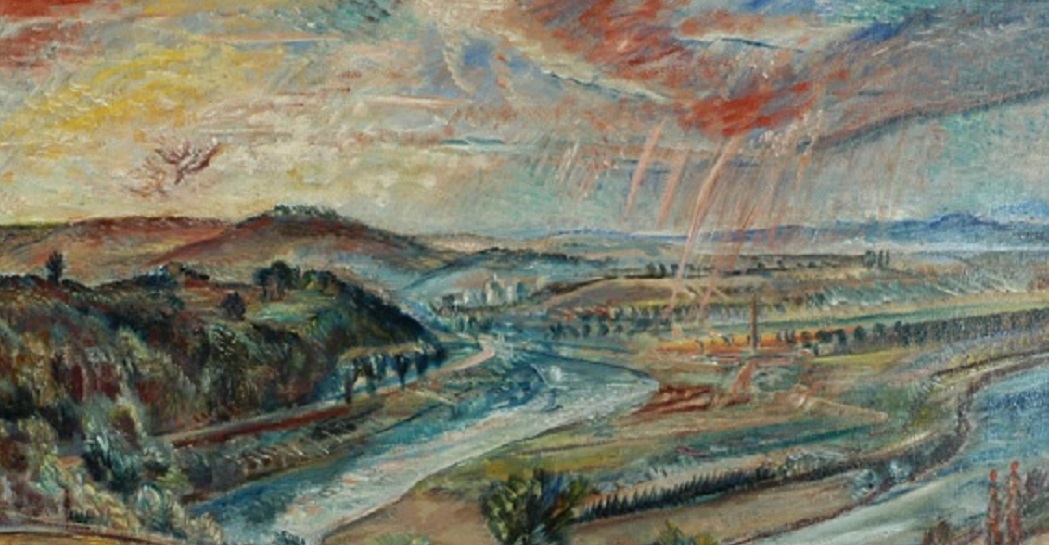The Artwork of the Month - October 2023
Ferruccio Ferrazzi,
Pioggia d'autunno (Temporale d'autunno), 1935
Oil on canvas, 98.5x136 cm
Courtesy from the Ferrazzi family for the Museo della Scuola Romana

In honour of the autumn rains, now perhaps no longer so frequent, the Museo della Scuola Romana opens in October with a painting by Ferruccio Ferrazzi entitled 'Pioggia d'Autunno'. From the Monti Parioli, from where the artist observes it, a Roman landscape, as yet undeveloped, opens up towards the valley where the Tevere River flows, forming a U around the Tor di Quinto countryside, bordered at times by dense trees and bushes, at others by banks and knolls of bare, reddish earth. The distances are coloured blue and light blue, like the river water, and the sky, stained yellow and red, is already ready for a storm, the first streaks of which can be seen. In the lower part of the painting, on the Parioli hill, human activities still continue, heedless of the imminent danger. On the left, in an enclosed area, probably that of the historic volleyball club, a rifle drill is in progress, aimed at birds mingling with the clouds; on the right, instead, two men with a dog point their guns at prey on the ground. The white sign next to them bears the artist's signature and the painting's date. Further to the right, beyond the fence, two gendarmes control the scene. In the vicinity of this area, the artist had both a studio and residence for many decades.
From a painting point of view, this work demonstrates the influence of French painting and in particular Cézanne, in the layering of the masses and the directional brushstrokes, in which light and colour form an unreal kaleidoscope. Nature is transfigured to the point of becoming expressive, beyond the real datum. The critic Bardi wrote, perhaps while observing this painting, "One day [---] we will notice the genuine contribution of Ferrazzi's personality to the creation of the new painting in Italy, and we will start from the skies, from his grave and solemn skies as on Judgement Day, from the clouds that cloud over the earth in a mixture of storm and greatness, of the infinite and the apocalyptic, of lightning and the sun, cycles that unleash a fury of beauty and enchantment" (P. M. Bardi, Ferrazzi inedito, in "Stile", 23 May 1943, p. 31).
Ferruccio Ferrazzi (Rome, 1891-1978). He represented one of the most original figures in the Roman artistic scene between the two wars; his resources drew on both 19th-century Northern European painting and the Italian tradition, leading him to continually experiment with pictorial means, as well as to search for a personal poetics in which symbolism, expressionism and a certain dramaticism coexisted.
His father Stanislao, a sculptor and copyist of paintings, initiated him and his brother Riccardo into the study of painting. In 1907, Ferruccio made his debut at the LXXVII Esposizione della Società degli Amatori Cultori di Belle Arti in Rome at the age of 16 and amazed the Roman environment with his independence from the dominant artistic models. The following year he won a scholarship from the Catel Institute, under which he was assigned as a tutor the landscape painter Max Roeder - close to the style of the Swiss painter Arnold Böcklin, one of the major exponents of Nordic Symbolism - who introduced him to the circle of German artists in Rome. In 1913 he won the National Artistic Pension and in 1914 he went abroad for the first time, following his father to Paris, where he studied old and modern painters, learning the techniques of Impressionism and Neo-Impressionism. Returning to Rome, in the following years he was influenced by Futurism, which he reworked in a personal manner. In 1916, he set up his own room at the LXXXV Esposizione della Società Amatori e Cultori di Belle Arti, causing a great scandal due to its disruptive novelty. It was appreciated by the Swiss collector Walter Minnich, who invited him to his home in Montreux, where Ferrazzi stayed for a year. In 1922, he married Horitia Randone, daughter of Francesco Randone, a master ceramist and lover of hermetic philosophies animated by principles of humanitarian socialism. In 1926 Ferrazzi received the Carnegie Prize from a jury chaired by Pierre Bonnard. In 1931 he exhibited at the Prima Quadriennale d'Arte Nazionale in Rome and in 1933 he was elected one of the members of the Reale Accademia d'Italia: he was one of the few academics not registered with the Fascist party.
Ferrazzi's range of interest extends from the applied arts, also understood on a monumental scale, to mural painting and easel painting. In 1941, he executed two large encaustic paintings in the Galilei Hall at the University of Padova. Years earlier, he had been commissioned to create seven tapestries for the Ministry of Corporations building (now the Ministry of Industry and Commerce) by the architects Piacentini and Vaccaro in Rome. At the time of the inauguration (30 Nov. 1932), Ferrazzi presented only the tapestry depicting the Corporations of Professionals and Artists, made by the Eroli company in Rome, while the remaining work is documented by preparatory cartoons. Due to their narrative and anti-rhetorical nature, the tapestries are not placed where planned.
In the post-war period, Ferrazzi continued his artistic and exhibition activities, in parallel with his teaching and management activities at the Vatican Mosaic Studio.
In 1951 he executed frescoes with religious subjects in the Basilica of Santa Rita da Cascia and the Chiesa di Sant'Eugenio in Rome. In 1954 he finished the large mosaic of the Apocalypse on the walls of the Mausoleo Ottolenghi crypt in Acqui Terme. In the 1950s, he also began to work as a sculptor.
Back to the section > The Artwork of the Month of The Museo della Scuola Romana












































